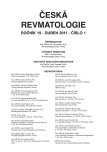The course of pregnancy in SLE
Authors:
D. Tegzová; K. Andělová 1
Authors‘ workplace:
Revmatologický ústav a Revmatologická klinika 1. LF UK v Praze, 1Ústav péče o matku a dítě v Praze
Published in:
Čes. Revmatol., 19, 2011, No. 1, p. 17-21.
Category:
Reviews
Overview
The course of pregnancy and lactation in patients with SLE is risky. The risk results from the diseases itself, its activity, organ involvement, preconception therapy and the treatment during mother’s pregnancy and lactation. A disease relapse manifesting as skin and joint involvement and leukopenia occurs most often; occurrence of a renal relapse is frequent as well. In the newborns of anti Ro and anti La positive mothers, there is a risk of lupus neonatorum with an irreversible grade III AV block. As a consequence of antiphospholipid syndrome, the risk of reccurent misscarriages is increased. Immunosuppressive therapy of SLE has severe risks considering pregnancy. Low dose glucocorticoids and antimalarials are safe. Azathioprin and cyclosporin A therapy may be considered in same cases, while cyclophosphamide is contraindicated. During treatment with immunosupressants an efficient contraception must be ensured and the drug need to be discontinued in time prior to planned conception. During the cyclophosphamide therapy, it is necessary to preventively ensure protection for the ovum prior to conception to avoid irreversible amenorrhea, preferably with the use of hormonal contraception. Freezing of an embryo is another possibility. Well coordinated therapy has a fundamental significance in monitoring the pregnant patients with SLE in risk. This should be commenced prior to pregnancy with a selection of right contraception and conception planning, when the disease is under control or completely in remission.
Key words:
systemic lupus erythematosus, pregnancy, pharmacotherapy
Sources
1. Gordon C. Long-term complications of systemic lupus erythematosus. Rheumatology 2002; 41 : 1095-1100
2. Urowitz MB, Gladman DD. How to improve morbidity and mortality in systemic lupus erythematosus. Rheumatology 2000; 39 : 238-244.
3. Manger K, Manger B, Repp R, et al. Definition of risk factors for death, and stage renal disease, and thromboembolic events in a monocentric cohort of 338 patients with systemic lupus erythematosus. Ann Rheum Dis 2002; 61 : 1065-1070.
4. Ostensen M, von Esebeck M, Viliger PM: Therapy with immunosupressive drugs and biological agents and use of contraception in patients with rheumatis disease. J Rheumatol 2007; Jun 34(6): 1266-9.
5. Lockshin MD, Reinitz E, Druzin ML, et al. lupus pregnancy. Case control prospective study demonstrating absence of lupus exacerbation during or after pregnancy. AmJ Med; 1984 Nov, 77(5): 893-8.
6. Oviasu E, Hicks J, Cameron JS. The outcome of pregnancy in women with lupus nephritis. Lupus 1991; Nov 1(1):19-25.
7. Julkunen H, Raaja R, Wallgren E, et al. Isolated congenital heart block: fetal and infant outcome and familial incidence of heart block. Obstet Gynecol 1993; Jul, 82(1): 11-16.
8. Izmirly PM, Kim MY, Lianos C, et al. Evaluation of the risk of anti SSA/Ro-SSB/La antibody-associated cardiac manifestations of neonatal lupus in fetuses of mothers with systemic lupus erythematosus exposed to hydroxychloroquine. Ann Rheum Dis 2010; Oct 69(10): 1827-30. Epub 2010 May 6.
9. Breur JM, Visser GH, Kruize AA, et al. Treatment of heart block with maternal steroid therapy: case report and review of the literature. Ultrasound Obstet Gynecol 2004; Sep, 24(4): 467-72.
10. Blanford AT, Murphy BP. In vitro metabolism of prednisolone, dexamethasone, betamethasone and cortisol by the human placenta. Am J Obstet Gynecol 1977; 27 : 264-268.
11. Ostensen M, Lockshin M, Doria A. Update on safety during pregnancy of biological agents and some immunosupressive anti-rheumatic drugs. Rheumatology (Oxford), 2008; jun 47 Suppl 3 : 28-31.
12. Janssen NM, Genta MS. The effects of immunosuppressive and anti-inflammatory medications on fertility, pregnancy and lactation. Arch Intern Med vol. 160 : 610-619.
13. Dostál C, Vencovský J. Těhotenství a SLE. Systémový lupus erytematodes. Medprint; 1997 : 147-153.
14. Briggs GG,Freeman RK, Yaffe SJ. Drugs in pregnancy and lactation. 5thed. Baltimore. MD: Williams and Wilkins, 1998.
15. Ostensen M. Safety on nonsteroidal antinflammatory drugs during pregnancy and lactation. Immunopharmacology 1996; 4 : 31-41.
16. Ostensen M, Ostensen H. Safety of nonsteroidal antiinflammatory drugs in pregnant patients with rheumatc diseases. J Rheumatol 1996; 3 : 1045-1049.
17. Parke A, West B. Hydroxychloroquine in pregnant patients with systemic lupus erythematosus. J Rheumatol 1996; 23 : 1715-1718.
18. Buchanan NMM, Toubi E, Khamasta MA, et al. Hydroxychloroquine and lupus pregnancy review of a series of 36 cases. Ann Rheum Dis 1996; 55 : 486-488.
19. Donnenfeld AE, Pastiszak A, Noah JS, et al. Methotrexate exposure prior and during pregnancy. Teratology 1994; 49 : 79-81.
20. Slater CA, Liang MH, McCune JW, et al. Preserving ovarian function in patients receiving cyclophosphamide. Lupus 1999; 8 : 3-10.
21. Caritis S, Sibai B, Hauth J, et al. Low aspirin to prevent preeclampsia in women at high risk. N Engl J Med 1998; 338 : 701-705.
22. Ginsberg JS, Kowalchuk G, Hirsh J, et al. Heparin therapy during pregnancy: risk to the fetus ad mother. Arch Intern Med 1989; 149 : 2233-2236.
23. Melissari E, Parker CJ, Wilson NV, et al. Use low molecular weight heparin in pregnancy. Thromb Haemost 1992, 68 : 652-656.
24. Hunt BJ, Doughty H, Majumdar G, et al. Thromboprophylaxis with low molecular weight heparin in high-risk pregnancy. Thrombo Haemost 1997; 77 : 39-43.
Labels
Dermatology & STDs Paediatric rheumatology RheumatologyArticle was published in
Czech Rheumatology

2011 Issue 1
Most read in this issue
- Sine syndromes in clinical picture of dermatomyositis
- Occurence of autoimmune diseases following the biological treatment
- The course of pregnancy in SLE
